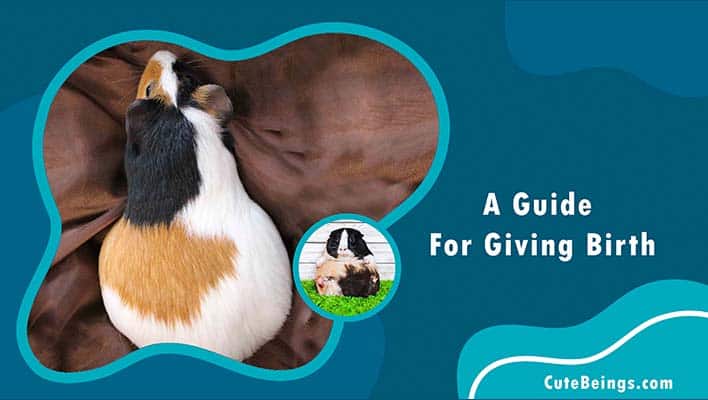Table of Contents
Guinea Pig Pregnancy
Pregnancy typically proceeds without any hazards and the birth process is smooth, thanks to the nature. After the breeding process, female guinea pig will become pregnant and her gestation period will last 59 to 72 days or 9 to 10 in weeks. Guinea pig pregnancy duration time is longer than other pet rodents.
If the gestation period goes on more than 72 days you need to seek a veterinarian immediately and there is a possibility that you would have to give up hopes on new born guinea pig babies.
The duration of 72 days is for one piglet and for half a dozen, pregnancy duration would be 59 to 62 days. So it means smaller the litter, pregnancy period would be longer and bigger the litter the pregnancy period will be shorter.
How to Identify a Pregnant Sow
It would be hard for you to identify right away by just observing your pet guinea pig but pregnant guinea pigs show a bloated belly during the later phases of pregnancy. If you weigh your pig daily in early stages you could simply tell that your female guinea pig is pregnant.
During the first month you won’t notice any changes in behavior in your cavy. Then you will notice that your pregnant guinea pig becomes extremely chubby in last three weeks as by this period piglets would reach close to half the body weight of pregnant mother. Also your sow will increase the food intake drastically and that will help her to gain weight.
Further pregnant female would drink more fresh water and that will make you understand that your sow is pregnant and you will have to refill the water bottle or basket more often.
What you should do if you think your Cavy is Pregnant?
My recommendation and the best thing are to take your pig to a vet for opinion. Vets can identify the pregnancy in various ways and could tell you the gestation period as well. Some may do scans on your pig to picture the babies in the womb.
Later vets would perform an x ray examination and palpate the piglets to see how they are doing in the womb. By doing so, they can observe the movement of babies and the babies’ heartbeats.
Nutrition Requirements of Your Pregnant Guinea Pig
-
Protein
-
Calcium
-
Vitamin C
-
Fiber
You need to provide enough nutrition for the safety of mother and babies.
Feeding Your Pregnant Guinea Pig
When your cavy is pregnant you need to pay extra attention to its diet and changes should be done progressively to evade any stress or digestive upset which could affect the pregnancy. Pregnant mother would need more food, as much as twice it used to eat. Diet should be mixed with hay and other required nutrition.
Follow these food habits when you suspect a pregnancy,
-
After mating process is over successfully you need to offer alfalfa hay instead of timothy hay. More calcium and protein can be found in alfalfa hay and your sow would need them badly as she is preparing for pregnancy. These nutrients will help your cavy in many ways such as avoiding hair thinning and hair loss.
-
Little bit of Lucerne hay. This would fulfill the need of increased protein and calcium but not essential.
-
Foods which contain Vitamin C (in small amounts)
During guinea pig’s pregnancy, a sow will need as much as three times of vitamin C than she normally does. Guinea pigs can’t make their own vitamin C so you need to provide them enough otherwise they will suffer from scurvy as humans. So it is very important to provide additional vitamin C to your pregnant pig.
Though you can add vitamin C to the water, feeding foods which are rich in vitamin C is recommended as Vitamin C could degrade in water quickly. If you are planning to add vitamin C to water you can do it by adding 200mg of vitamin C to one liter of water.
Fruits and vegetables such as kale, dandelion greens, parsley, brussel sprouts, cauliflower, broccoli leaves, strawberry, kiwi oranges, citrus and cabbage are rich in vitamin C. A full cup of dandelion greens and brussel sprouts contain about 200mg of vitamin C while orange and cabbage contain less amount of vitamin C.
You can avoid conditions such as toxaemia by doubling up vitamin C intake of your pregnant cavy. With the recommendation of a vet you can also provide vitamin C orally
-
Leafy vegetables such as Broccoli and kale
-
High quality commercial guinea pig pellet (in small amounts)
You can always get an opinion for supplements and medicines from your veterinarian so your guinea pig can have safe and comfortable delivery.
👉 Important: Do not overfeed and keep an eye of weight gain as your cavy will find hard to carry extra weight in later stages of pregnancy. This will help to prevent serious state called pregnancy toxaemia. Further overfeeding can cause large babies and sow would find it very difficult to pass them in delivery.
Pregnancy Obstacles
The most common complications seen in pregnant guinea pigs are toxemia (eclampsia), mastitis, hypocalcemia (low calcium), blood loss and uterine prolapse. Always observe your cavy’s appetite, stools and behavior and if you notice something wrong contact your vet as soon as possible.
Pregnancy Ketosis or Pregnancy Toxaemia
You need look after you pregnant sow carefully and watch out for any sickness. If the fetuses are demanding more energy than sow can supply, your pregnant cavy is at risk of pregnancy toxemia.
This is a fatal condition to your cavy during the pregnancy period and soon after giving birth. Various health conditions can cause toxaemia and obesity and fasting can be pointed out as the predisposing factors.
Ketones will be generated when pregnant guinea pig’s body metabolizes fat and these ketones can be measured using strips for urine.
If you notice any depression signs such as weak, quiet, lethargic and anorexia your sow could be suffering from pregnancy toxaemia. Further your guinea pig will have muscle contractions or difficulty in breathing. You can avoid this health condition by preventing obesity and offering sufficient energy in the diet in late gestation.
Some medical professionals suggest adding small amount of glucose to water in late gestation but the best thing is to contact your vet regarding this matter for lucrative advice.
Low blood calcium and high blood pressure are caused by this metabolic disorder. It further causes loss of appetite in early pregnancy period, worsening to muscle twitching and coma. This health condition can be prevented or reduced by providing enough water and high calcium greens throughout the pregnancy period.
Take your pregnant pig to vet more often to avoid pregnancy related issues or sickness.
Delivering the Piglets
A normal delivery would take roughly an hour. When delivering it usually take about five minutes between the entrances of each guinea pig pup. Breeding guinea pigs is not that easy as stillbirths and abortions are very common among guinea pigs.
Pregnancy is a very sensitive thing for guinea pigs as 20% of pregnant mothers on average are dying during the delivery. While some mothers are giving birth naturally and without assistance others require vet’s help to give birth. Some guinea pig mothers need medications and sometimes even caesarean section. So always seek your vet for advice regarding the pregnant guinea pig care and birthing procedure.
Pregnancy Facts
-
When the female guinea pig is carrying more babies, the pregnancy period is shorter.
-
Due to lack of experience your guinea pig will need assistance in first pregnancy and after it will manage everything by itself.
-
Do not stress out your guinea pig by making any changes to the guinea pig cage as it will lead your cavy to stop eating and drinking.
-
During the whole pregnancy period make sure to offer quality foods to your guinea pig and keep her very comfortable.
-
Do not limit your pregnant guinea pig from exercising. She would need exercises to keep the weight in balance and to keep up her strength.
-
When you are lifting a pregnant pig, make sure to support her hind quarters. If you don’t support her hind quarters fetus may be in risk and have an abortion.
-
You need to pay attention to the hot weather. Several cases of death have been reported due to hot weather conditions in late pregnancy periods. In winter or cooler months this wouldn’t be a problem but in summer you will need to adjust your air condition settings to provide a comfortable environment to your pregnant guinea pig in her last few days in pregnancy.
-
Guinea pigs usually do not expect a special setting or a place to give birth. So you don’t have to arrange a nesting box and they will do the delivery in their hutch.
-
If you have few pregnant guinea pigs, you need to separate them as they reach to their delivery date. The reason is females release pheromones in labor and that can trigger other pregnant guinea pigs to perform premature labor. So always be careful if you have few pregnant pigs living in close proximity.
-
Performing a caesarian section on pregnant sow is always a hard choice as the survival rate is pretty low. But, if there are birth complications sow will have to go through a caesarian section. Successful rate is very low even an experienced vet performs a caesarian section so after a surgery keep your pig separate and quiet till she fully recovers.
-
Until guinea pig become pregnant its hip bones are growing closer. If your guinea pig is six weeks old and in its first pregnancy seek advice from your vet. Find out whether your sow is able to have a normal delivery and if your veterinarian suggests a caesarian surgery always go for it as it will save your sow’s life.
-
If you don’t breed your sow until she is 12 months old, the ligaments near the pelvic bone may happen to be stiff. Usually this will make it almost impossible for older guinea pig to have a normal delivery. In this situation your vet has to go for a cesarean section to take out piglets and this is exceedingly dangerous for your guinea pig. Though every 12 month old sow won’t have this issue seek your vet’s recommendation regarding this matter as risking your pig’s life is not worth it.
-
While your sow is pregnant if she lived with a female you can keep her with your new born pups and the mother as females are usually happy to take care of new born baby guinea pigs.
-
Females can be pregnant soon after they give birth to their litter so keep the male guinea pig away after your sow give birth and in late pregnancy period to avoid any unplanned guinea pig pregnancy.
-
In theory a sow can bear five or six litters a year. But it will cause a huge strain on body and her mental stability. So performing such breeding is not a good practice. Limit the breeding, maximum two times a year to make certain the well being of mother. You can also consider retiring your sow after 2 years to avoid such tension on her body.
-
Your female definitely needs rest between pregnancies to heal and to make the body fit for next pregnancy. So leave them alone to have a good rest so they can relax and be happy.
Very important: after giving birth your sow might be suffering from medical complications so always observe your pig and seek advice immediately from your vet if needed.
Learn the Process of Labor and Birth
-
As a sow is nearing the delivery date the area between the pelvic bones starts to expand. You can notice that if you touch her underbelly area a couple of centimeters ahead of anus. This expansion normally starts between 1 to 2 weeks before the delivery and the dilation will reach its maximum before 24 hours of birth.
-
In many occasions guinea pigs give birth at night and you would see a daytime delivery rarely.
-
Sow will make a cry as she begins the delivery process.
-
For guinea pigs labor will last from 10 minutes to 30 minutes and there will be 5 to 10 interval between births. Females give birth while sitting up and bending their bodies or squatting.
-
When the delivery process is started first baby will appear after about 5 minutes. Normally females would have 2 to 4 piglets at a time and sometimes it can be changed. Be aware of the labor time as sow will need medical attention if the labor last longer than 30 minutes or too much bleeding occurs.
-
Each piglet has its own amniotic sac and they will emerge head first. Usually mother will remove the sac from its teeth and eat it. After she will clean the guinea pig pups. If you observe a piglet with the sac remaining on its face use your finger nails to break open the sac.
-
Placenta will come out after giving birth to all babies and sow will consume it as a supply of nutrition.
-
Finally make sure that mother has given birth to all pups and not facing difficulties giving birth. You can help the sow to ensure that no piglets are stuck inside the womb.
Seek Advice From Your Veterinarian If You Observe These Changes During The Pregnancy
-
Eliminations: fecal droppings are less in volume or absent
-
Discharge: if you notice any bloody or tarnished vaginal discharge
-
Appetite: changes in food intake
-
Attitude: exhibition of lethargy or lack of energy signs
Always seek medical advice if needed as you don’t need to risk the life of your guinea pig and the unborn or newborn pups.
Further Reading
You already know that a pregnant guinea pig is a hazard to her life. You must be aware of insurance in order to claim compensation or extend medical cover to them. To keep her safe, read this post.

Hello, my name is James and I’ve been caring for tiny pets for over 14 years with a passion. I enjoy passing on my expertise to other individuals in order for them to have the same amount of enjoyment as I do.




